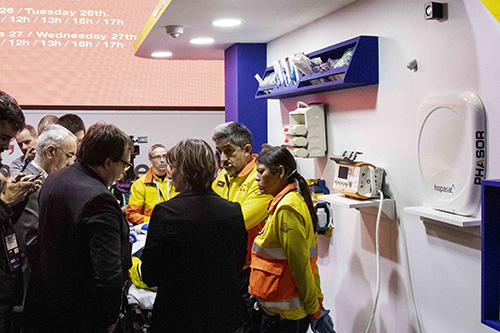Hispasat Highlights Role of Satellites in 5G Environment at MWC19 Barcelona
 Barcelona, Spain, Feb. 26, 2019 — Hispasat, the Spanish satellite and telecommunications operator, is participating in the ongoing Barcelona Mobile World Congress to show the importance of satellites in the development of mobile networks and in connecting towers with their backbone network via satellites to provide cellular coverage in remote or uninhabited areas.
Barcelona, Spain, Feb. 26, 2019 — Hispasat, the Spanish satellite and telecommunications operator, is participating in the ongoing Barcelona Mobile World Congress to show the importance of satellites in the development of mobile networks and in connecting towers with their backbone network via satellites to provide cellular coverage in remote or uninhabited areas.
With this cellular backhaul service, satellites facilitate a more rapid and less expensive deployment for operators in these cases, and they contribute to extending mobile communications to areas that otherwise would not be reached.
With satellites playing a relevant role in the 5G ecosystem, the satellite industry is working on being integrated into the 5G environment and forming part of hybrid networks that will provide connectivity services by combining terrestrial and space technologies in the most efficient manner. Satellites also provide broadband multicast capability to facilitate, for example, mass software updates to millions of users at the same time or the transmission of high-quality video content. Satellites enable high availability networks to be formed, providing the 5G ecosystem with an infrastructure independent of any incident or disaster that may affect the terrestrial networks.
The 5G Barcelona consortium formed by the Generalitat of Catalonia, SEM, Vodafone, i2CAT (with the collaboration of CTTC), Hispasat, Juniper Networks e Iecisa, and other members of the 5G Barcelona will carry out a demonstration involving connectivity with an ambulance in a 5G environment at the stand of the Generalitat during MWC19 Barcelona. In the future this connectivity will make it easier for emergency medical personnel to receive instructions from specialists from a hospital, since it will be possible to establish full audiovisual connection between the vehicle and the hospital. This will allow the specialist to monitor the patient’s status in real time, which may be key to their survival and their subsequent recovery.
The demonstration will be carried out on a supposed patient suffering from pneumothorax who is urgently transferred to the hospital. In the 5G ecosystem, terrestrial and satellite connections are combined to ensure permanent connectivity of the ambulance to the hospital during its entire journey so that the specialists can guide the transfer from the hospital and implement the most appropriate medical protocol based on the parameters received.
To conduct this demonstration, a model of an ambulance with 4G/5G connections and a satellite antenna, connected to an Hispasat’s satellite, has been installed at the stand of the Generalitat, which will allow the demonstration to be carried out in all cases of use, both in urban areas with broad development of the 5G connection and in areas with only 4G connection or without terrestrial telecommunications networks, where the satellite will have to close the circle with spatial technology. It will only be possible to offer a complete connectivity service with a hybrid network that combines different technologies, especially in cases of mobility when areas with less extensive terrestrial mobile coverage are transited.
The 5G Barcelona consortium is an initiative promoted by the Generalitat of Catalonia, the Barcelona City Hall, Mobile World Capital Barcelona, the i2CAT Foundation, Catalan Telecommunications Technology Centre (CTTC), Atos and the Polytechnic University of Catalonia (UPC), which have been joined by Hispasat and the European Space Agency in recent months.
During the event, Hispasat will present, along with the model of the connected ambulance, the first prototype antenna especially designed to adapt to the requirements of land-mobility applications for road transport. Thanks to this flat antenna that has a height of just 5 cm, professional and emergency vehicles will be connected via satellite in any environment where they must operate, and they may use applications such as operational telematics or have high-quality Internet access during the journey to the hospital. This antenna, designed by the Phasor company under the specifications of Hispasat, has fully electronic steering and enables connectivity services to be efficiently and reliably offered in mobility with a high bandwidth.
Related Articles:
Hispasat Partners with ATRESMEDIA Foundation in Broadcasting FAN3 Channel to Hospitalized Kids
Hispasat, Media Broadcast Satellite to Distribute the FunBox UHD Channel in EMEA
Italian Infrastructure Group Atlantia Purchases Majority Stake in Hispasat
HISPASAT Sponsors Apollo Space Contest to Promote Space Research Among Schoolchildren





